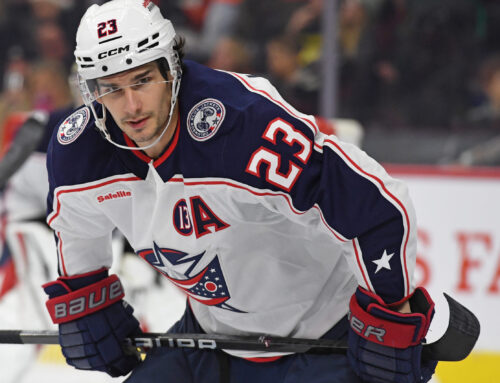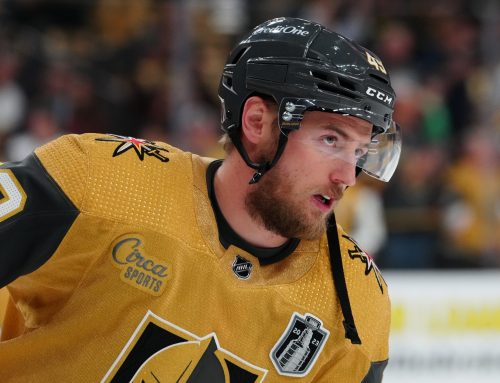This week, after a brief break for Bubble Week, we are here to finish our division review. Over the past few weeks we have looked at advanced stats and flagged players whose point pace from 2023-24 looked unsustainable. Our goal is to identify players that may be in line for a return to form, and those who it might be wise to let fall a little on draft day.
As a reminder here is some context setting from the earlier article.
In order to make this process a bit more concrete we are going to focus on three stats from the Dobber Reports; five on five team shooting percentage (5on5 S%), individual points percentage (IPP), and individual shooting percentage (S%). These are certainly not the end all be all of player evaluation but do tend to flag players who are likely to see a different point pace in the future.
With all of these stats thought it is important to take them into context. Not just what would an average player do, but how does this number compare to their career numbers? In order to do that I grabbed the same data points for the 2023-24 season and am comparing them to each player's recent career average. Broadly speaking, and barring changes in the player's situation (changing teams, sudden promotion to a top line etc.) we would expect these numbers to return that career average.
For our first set of players, we are looking at players who performed better than their recent career averages in each of our three stats. A broad statement we can say about each of these players is that there were more goals scored while they were on the ice than usual, they got in on more of goals than usual, and they themselves scored on a higher percentage of their shots than usual. In short, all of these players could be in danger of less point production in 2024-25.
| 5on5 S% | IPP | SH% | ||||||
| Name | Pos | Team | 23-24 | Δ From Average | 23-24 | Δ From Average | 23-24% | Δ From Average |
| SAM REINHART | R | FLA | 10 | 1.6 | 71.8 | 10.1 | 24.46% | 9.00% |
| LUCAS RAYMOND | R | DET | 10.5 | 2.55 | 71.3 | 8.55 | 19.02% | 6.44% |
| CHARLIE COYLE | C | BOS | 9.7 | 1.45 | 75 | 9.15 | 17.24% | 5.39% |
| J.T. COMPHER | C | DET | 11 | 3 | 57.1 | 3.9 | 17.59% | 3.92% |
| DRAKE BATHERSON | R | OTT | 8.7 | 0.1 | 72.5 | 6.8 | 14.29% | 3.42% |
It is likely no surprise to anyone to see Sam Reinhart on this list. He had a great season. He has been highlighted all over the place for his success, his free agency status, and the fact that his shooting percentage was high. And it was quite high. To illustrate: if he had shot at 15.6 percent (his average over the last three seasons) he would have put up 36 goals. 20 fewer than his 2023-24 total. That would have left him with a 74-point pace. Still a good season for him, but significantly less elite. Be very cautious about drafting Reinhart as a 50-goal scorer. It looks very unlikely that he will be able to repeat that feat.
After going in depth on Lucas Raymond last week we won't spend too much time here, but these numbers just emphasize that it took some favorable percentages for Raymond to hit his career high 72-point pace. He is going to need to repeat those numbers (which is unlikely particularly in the shooting percentage numbers), or find a way to get more pucks on net (shoot more or more ice time) in order to sustain those numbers into 2024-25.
I am similarly concerned about Charlie Coyle. His numbers are not as dramatic as Reinhart's, and some of the increases could be due to the fact that he got the best deployment of his recent career. Your team shooting percentage is bound to go up when you are on the ice with better players. Ultimately though it looks like a few too many things went a little too right and he is now going to have to compete with Elias Lindholm in addition to Pavel Zacha for prime minutes.
These particular numbers aren't huge red flags for J.T. Compher and Drake Batherson though clearly both shot a little too effectively in 2023-24. They do get more concerning though when you add in the context of the rest of the season, especially for Batherson. These slightly favorable numbers only helped him produce a 66-point pace. If we dig a little deeper, he actually saw an overall time on ice decrease for the second season in a row and was down shooting below two and a half shots per game. His expected goal numbers were the lowest of his last three seasons. His percentage of his team's power play was also the lowest it has been in four seasons. He is still getting over 18 minutes a night on average which on the one hand is positive, meaning he is still getting decent minutes, but on the other decent minutes is producing fewer shots, lower expected goals, and a 66-point pace. Given his age and projected potential, we would really be hoping to see a lot of his numbers trending in the other direction. The numbers do not paint a picture of a player who is poised to have a better season in 2024-25 so we are really relying on growth from the player or a change in deployment if we want to see that next step forward.
To switch gears now, let's focus on players who might be due for a bounce back. Again, in a similar analysis process we are looking at players who's shooting percentages and IPP were lower than expected. So basically, we can say all of these players had fewer goals scored when they were on the ice and were getting in on fewer of those goals.
| 5on5 S% | IPP | SH% | ||||||
| Name | Pos | Team | 23-24 | Δ From Average | 23-24 | Δ From Average | 23-24% | Δ From Average |
| COLE CAUFIELD | L | MTL | 9.8 | -1.1 | 60.7 | -4.55 | 8.92% | -5.24% |
| MATTHEW TKACHUK | R | FLA | 9.2 | -2.3 | 69.3 | -0.75 | 9.29% | -4.93% |
| TAGE THOMPSON | C | BUF | 8.6 | -2.4 | 67.5 | -3.85 | 11.79% | -3.67% |
| EETU LUOSTARINEN | L | FLA | 6 | -2.05 | 55.1 | -7.3 | 10.00% | -2.04% |
| JOHN TAVARES | C | TOR | 8.1 | -1 | 63.1 | -3.95 | 10.39% | -1.86% |
There is a lot to like for Cole Caufield going forward. On the surface, a 65-point pace isn't a step forward for him, but unlike Batherson, basically every other number screams this guy should be doing better. He upped his overall time on ice to just shy of 20 minutes a night. He was shooting just shy of four times per game. He had the largest share of his team's power-play time of his career, the highest expected goal numbers of his career. This easily could have been a step forward season for Caulfield potentially to the tune of a 75–80-point pace. Consistent top line, top power play is likely a lock for Caulfield. If so, points per game is certainly in the cards.
Matthew Tkachuk is a bit of an interesting case. He had two 100 plus point seasons, followed up by a 90-point pace 2023-24. There are some mixed numbers here. On the one hand shooting percentage looks a little too low indicating maybe a rebound, but on the other he saw almost a two-minute drop in time on ice, a drop in shot rates, and a big drop in expected goals. One other factor is his incredibly slow start. He started with 20 points in his first 29 games (a 57-point pace). In his last 51 games he put up a 109-point pace. Ninety points seems a pretty safe full season floor because it looks like even with the decrease in ice time, shot rates, and slow start he maybe deserved a little better. It seems pretty reasonable to expect something in the 95–105-point pace.
Tage Thompson is another complicated situation. His underlying numbers were clearly low in 2023-24 compared to recent seasons, which is why he is on this list, but the challenge is in figuring out what we should actually expect to be his baseline. For example, his team five on five shooting percentage dropped two and a half percent from recent averages, but those averages included two years of over 10 percent. Those are unusual numbers and typically associated with elite scorers, but not even Connor McDavid or Auston Matthews manage that every year. It dropped to a little under nine percent, which in any other context would be pretty unremarkable. Sure, it could be a little higher, but it is certainly within the margin of error for a top line player. There are plenty of top line, 90-point players who are in the range of a 9.5 team shooting percentage. Similarly, his personal shooting percentage dropped three and a half percent, but only to around 12 percent. Which again is a reasonable shooting percentage for a top line player. Other top line players with a 12ish percent shooting percentage over the last three years include Jack Hughes, Ryan Nugent Hopkins, and Alex Debrincat. The point is yes, these stats are maybe a little low as there are lots of top line players who are shooting in the 13-14 percent range, and who have a team shooting percentage around 9.5 percent. The problem is a little low doesn't make Thompson's 66-point pace into a 100-point one, which was many drafter's expectation going into 2023-24. Adjust some of those numbers up and you get a 70 maybe 75-point season in the best case? Long story short I need to see something from Thompson before assuming he can hit those 90 plus point heights again.
That is all for this week
Do your part to support organizations working to make hockey for everyone.






 ANA
ANA UTA
UTA MIN
MIN CAR
CAR MTL
MTL NYI
NYI VGK
VGK DET
DET ARI
ARI
